Bernina Bernette 33 Manual
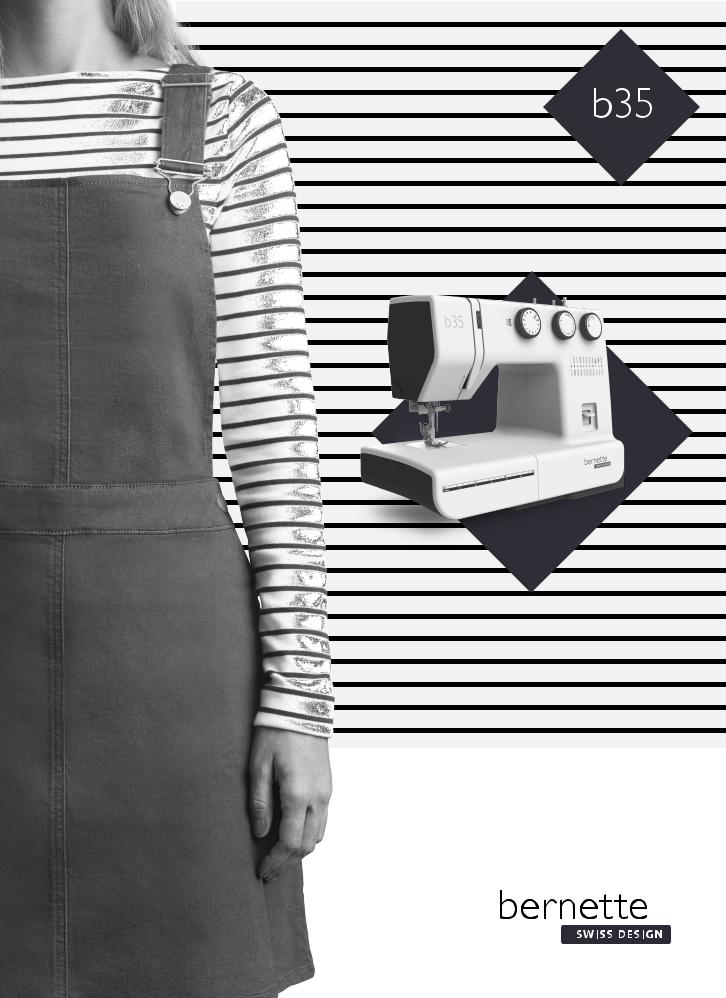
Instruction Manual

TABLE OF CONTENTS
ESSENTIAL PARTS
Names of Parts |
6 |
Standard Accessories |
7 |
Dust cover |
7 |
Sewing table |
8 |
Accessory box |
8 |
Free arm Sewing |
8 |
GETTING READY TO SEW |
|
|
|
Connecting the Power Supply |
9 |
Controlling the Sewing Speed |
9 |
Presser foot lever |
10 |
Changing the Presser Foot |
10 |
Attaching and removing the presser foot holder |
10 |
Changing the needle |
11 |
Fabric and Needle Chart |
11 |
Setting Spool Pins |
12 |
Removing or Inserting the Bobbin Case |
12 |
Winding the Bobbin |
13 |
Threading the Bobbin Case |
13 |
Threading the Machine |
14 |
Needle threader |
14 |
Drawing Up Bobbin Thread |
15 |
Thread tension dial |
15 |
Stitch pattern selector knob |
16 |
Stitch length knob |
16 |
Stitch width knob |
16 |
Reverse sewing lever |
17 |
Lowering and raising the feed dog |
17 |
BASIC SEWING |
|
|
|
Straight stitch |
18 |
Changing the Sewing Direction |
18 |
Seam Guide Lines |
19 |
Turning a Square Corner |
19 |
UTILITY STITCHES
Zigzag |
19 |
Overcasting |
20 |
3-step zigzag |
20 |
Stretch-Overlock Stitch |
21 |
Triple straight stitch |
21 |
Triple zigzag |
22 |
Sewing Buttons |
22 |
Automatic Buttonhole |
23 |
Buttonhole with cord |
25 |
Zipper Application |
26 |
Blindstitch |
27 |
Rolled Hem |
28 |
DECORATIVE STITCHING |
|
|
|
Vari-Overlock (scallop hem) |
29 |
Smocking |
29 |
Appliqué |
30 |
Stretch Stitch Patterns |
30 |
CARE OF YOUR MACHINE |
|
|
|
Cleaning the Bobbin Case and the Shuttle Race |
31 |
Dismantling Shuttle Race Unit |
31 |
Assembling Shuttle Race Unit |
31 |
Oiling |
32 |
Cleaning the feed dog |
32 |
Troubleshooting |
33 |
STITCH PATTERN |
|
|
|
Overview |
34 |
3

IMPORTANT
The following basic safety precautions must be observed when operating an electrical device:
Please read the instruction manual carefully before using this machine.
Keep the instruction manual at a suitable place with the machine and hand it over if you give the machine to a third party.
When the machine is not in use or left unattended, always disconnect the machine from the power supply system. Unplug it from the outlet.
DANGER!
To reduce the risk of electric shock:
1.Never leave the machine unattended when it is plugged in.
2.Always unplug this machine from the electric outlet immediately after using and before cleaning.
3.LED RADIATION: Do not look directly at the LED using an optical instrument.
WARNING!
To reduce the risk of burns, fire, electric shock or injury to persons:
1.The machine mustn’t be used by children under 8 or by people with reduced physical, sensory or mental capabilities or if there is a lack of experience and knowledge how to operate the machine. Unless they have been given instruction concerning the use of the machine and the involved risks by a person who is responsible for their safety.
2.Do not use this machine as a toy. Close attention is necessary when this machine is used by children, near children or people with reduced sensation.
3.Use this machine only for its intended use as described in this manual. Use only accessories recommended by the manufacturer.
4.Children should be supervised to ensure that they do not play with the machine.
5.Never operate this machine if it has a damaged cord or plug, if it is not working
properly, if it has been dropped or damaged, or dropped into water. Return the machine to the nearest authorized dealer or service centre for examination, repair, electrical or mechanical adjustment.
6.Never operate the machine with any air openings blocked. Keep ventilation openings of the machine and the foot control free from accumulation of lint, dust, and loose cloth.
7.Keep fingers away from all moving parts. Special care is required around the machine needle.
8.Always use the proper stitch plate. Using the wrong stitch plate can result in needle breakage.
9.Do not use bent needles.
10.Do not pull or push the fabric while sewing. This can result in needle breakage.
11.Switch the machine off (“O”) when making any adjustments in the needle area, such as threading or changing the needle, threading the bobbin, or changing the presser foot, and the like.
12.Always unplug the machine when performing cleaning or maintenance worksuch as replacing the sewing light or when making any other user maintenance adjustments mentioned in the instruction manual (disconnect the power plug). Cleaning and maintenance work must not be carried out by children without supervision.
13.Never drop or insert any object into any openings.
14.Use this machine only in dry and protected areas. Never operate the machine in a damp or wet environment.
15.Do not operate the machine where aerosol spray products are being used or where oxygen is being administered.
16.To disconnect, turn the power switch to (“O”)(off), then remove the plug from the outlet. Do not unplug by pulling the cord, instead grasp the plug to pull it from the outlet.
17.If the supply cord of the foot control is damaged, it must be replaced by the manufacturer or an appropriate service agent or a similar qualified person in order to avoid endangerment.
18.Never place anything on the foot control.
19.The machine may only be used in combination with a type C-1028 (100-120 V) or KD-2902 (220-240 V) foot control.
4
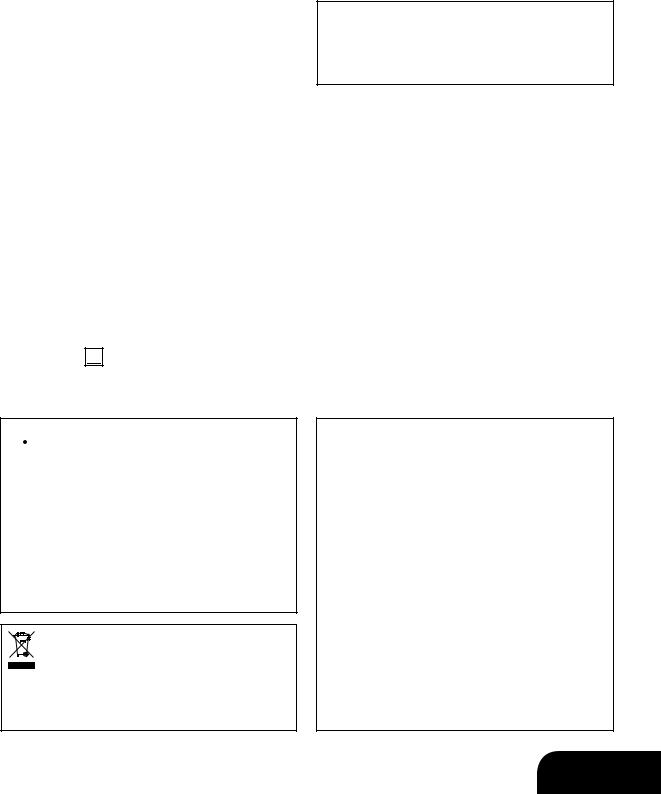
20.The sound pressure level during normal operation is lower than 75dB(A).
21.This machine is provided with double insulation (except U.S.A/Canada). Use only identical replacement parts. See instructions for Servicing of double-insu- lated products.
SERVICING OF DOU- BLE-INSULATED PRODUCTS
In a double-insulated product, two systems of insulation are provided instead of grounding. No grounding means is provided on a doubleinsulated product nor should a means for grounding be added to the product. Servicing a double-insulated product requires extreme care and knowledge of the system and should only be done by qualified service personnel. Replacement parts for a double-insulated product must be identical to those parts in the product. A double insulated product is marked with the words «DOUBLE INSULATION» or «DOUBLE INSULATED».
The symbol  may also be marked on the product.
may also be marked on the product.
All rights reserved
For technical and product improvement reasons, the machine‘s features, parts and accessory are subject to unannounced changes and alterations at any time. The accessory included can differ from country to country.
PLEASE NOTE:
If the machine is stored in a cold room, it should be brought to a warm room about one hour before use.
SAVE THESE INSTRUCTIONS!
 WARNING:
WARNING:
This machine is intended for household use only. If used intensively or commercially, regular cleaning and especially attentive care is required.
Signs of wear and tear owing to intensive or commercial use are not covered automatically, even if they occur within the warranty period. The decision on how to deal with any such cases rests with the local authorised servicing staff.
Please note that on disposal, this product must be safely recycled in accordance with relevant National legislation relating to electrical/electronic products. If in doubt please contact your retailer for guidance. (European Union only)
Europe only: This appliance may only be used by children over eight and by persons with reduced physical, sensory or mental capabilities or by persons who lack experience and knowledge of how to operate the machine under supervision, after instruction on how to use the equipment safely and once they have understood the potential dangers. Children shall not play with the appliance. Cleaning and user maintenance shall not be made by children without supervision.
Outside of Europe (except for the USA and Canada): This appliance may only be used by persons (including children) with reduced physical, sensory or mental capabilities or by persons who lack experience and knowledge of how to operate the machine under supervision and after instruction on how to use the equipment safely by a person responsible for their safety. Children should be supervised to ensure that they do not play with the appliance.
5
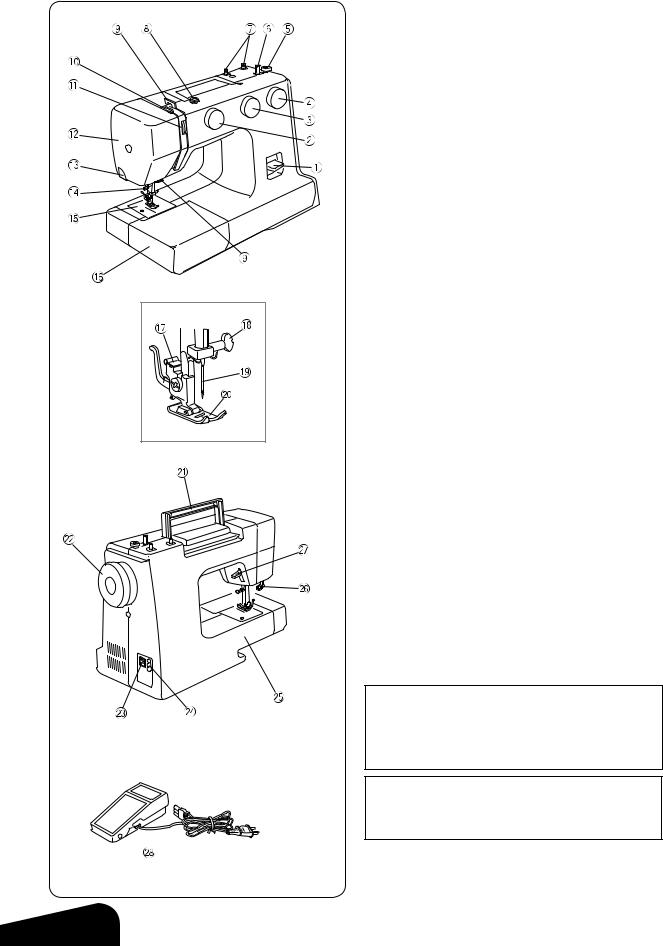
ESSENTIAL PARTS
Names of Parts
 Reverse sewing lever
Reverse sewing lever
 Stitch pattern selector knob
Stitch pattern selector knob
 Stitch length knob
Stitch length knob
 Stitch width knob
Stitch width knob
 Bobbin winder stopper
Bobbin winder stopper
 Bobbin winder spindle
Bobbin winder spindle
 Spool pin
Spool pin
 Bobbin winder pre-tension
Bobbin winder pre-tension
 Thread guide
Thread guide
 Thread take-up lever
Thread take-up lever
 Thread tension dial
Thread tension dial
 Head cover
Head cover
 Thread cutter
Thread cutter
 Needle threader
Needle threader
 Stitch plate
Stitch plate
 Sewing table (accessory box)
Sewing table (accessory box)
 Presser foot holder
Presser foot holder
 Needle clamp screw
Needle clamp screw
 Needle
Needle
 Presser foot (Zigzag foot)
Presser foot (Zigzag foot)
 Carrying handle
Carrying handle
 Handwheel
Handwheel
 Power switch
Power switch
 Power/Foot control connection
Power/Foot control connection
 Free arm
Free arm
 Buttonhole lever
Buttonhole lever
 Presser foot lever
Presser foot lever
 Foot control*
Foot control*
PLEASE NOTE:
To carry the sewing machine, hold the carrying handle with your hand, and support the sewing machine with the other hand.
PLEASE NOTE:
Design and specifications are subject to change without prior notice.
* The foot control included may differ from the illustration.
6
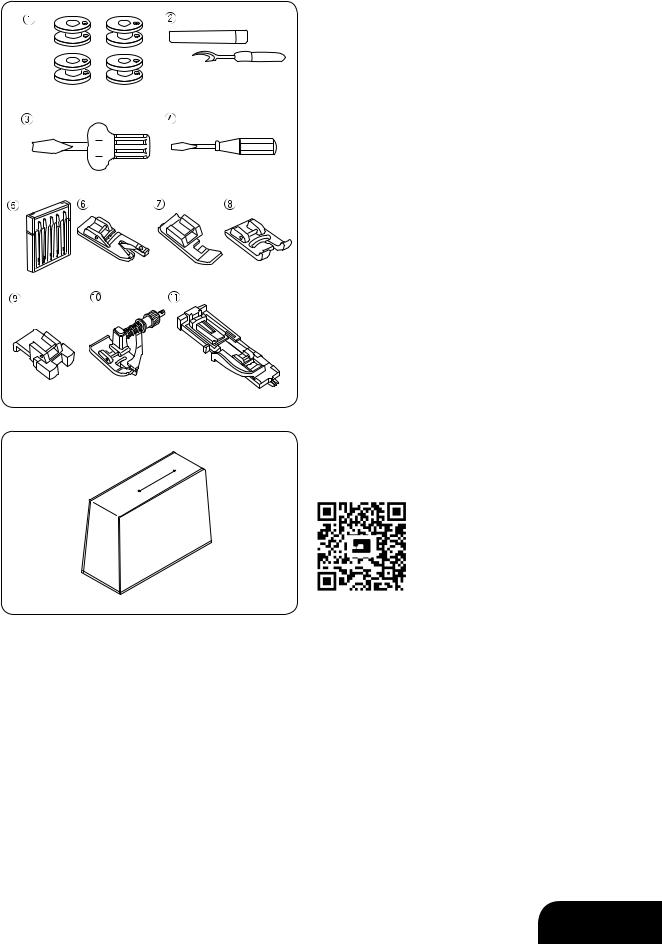
Standard Accessories
 Bobbins (4x)
Bobbins (4x)
 Seam ripper (buttonhole opener)
Seam ripper (buttonhole opener)
 Screwdriver (large)
Screwdriver (large)
 Screwdriver (small)
Screwdriver (small)
 Needle assortment
Needle assortment
 Hemmer foot
Hemmer foot
 Zipper foot
Zipper foot
 Satin stitch foot
Satin stitch foot
 Button-sew-on foot
Button-sew-on foot
 Blindstitch foot
Blindstitch foot
 Buttonhole foot with slide
Buttonhole foot with slide
More information on optional accessories can be found on our website:
http://www.mybernette.com/accessories
Dust cover
Sewing instructions for your own personalized dust cover are available at:
www.mybernette.com/cover
7
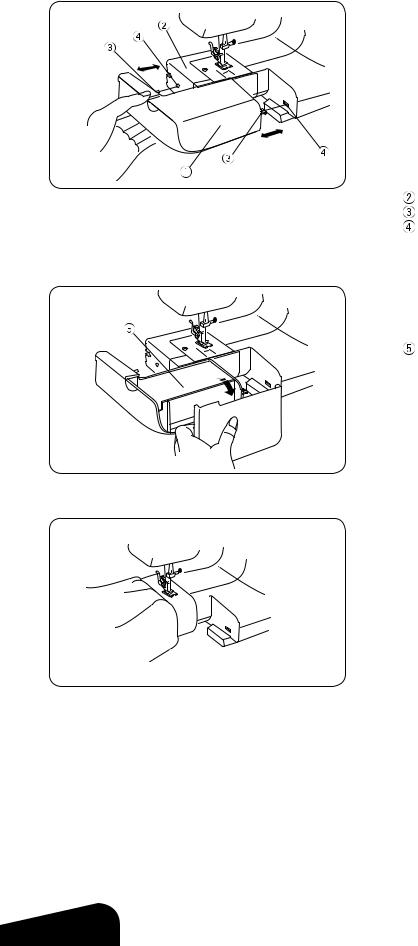
Sewing table
The sewing table increases the sewing area and is easy to remove for freehand sewing.
•Removing the sewing table:
Pull the table away from the machine.
 Sewing table
Sewing table
•Attaching the sewing table:
Slide the sewing table along the free arm and insert the guides into the openings until the table locks into the machine.
Free arm Guide Hole
Accessory box
The accessories are stored inside the sewing table. Unfold the cover to open the accessory box.
Accessory box
Free arm Sewing
Free arm sewing is used for stitching sleeves, waistbands, pant legs or any other tubular garments. It is also useful for darning socks or mending knees or elbows.
8
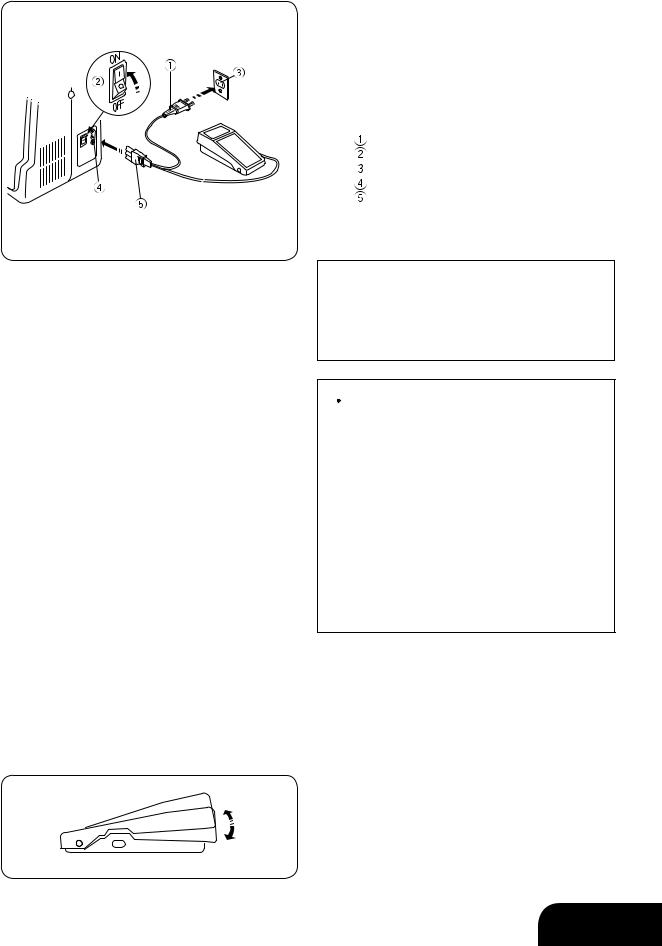
GETTING READY TO SEW
Connecting the Power Supply
 Switch off the power switch.
Switch off the power switch.
 Insert the machine plug into the Power/Foot control connection.
Insert the machine plug into the Power/Foot control connection.
 Insert the power supply plug into the wall outlet.
Insert the power supply plug into the wall outlet.
 Turn the power switch on.
Turn the power switch on.
Power supply plug
Power switch
Wall outlet
Power/Foot control connection Machine plug
 CAUTION:
CAUTION:
Before connecting to the power supply, make sure the voltage shown on the machine conforms to your electrical power.
 WARNING:
WARNING:
While in operation, always keep your eyes on the sewing area, and do not touch any moving parts such as the thread take-up lever, handwheel or needle.
Always turn off the power switch and unplug from the power supply:
-when leaving the machine unattended.
-when attaching or removing parts.
-when cleaning the machine.
Do not place anything on the foot control, otherwise the machine will run intermittently.
Controlling the Sewing Speed
Sewing speed can be varied by the foot control.
The harder you depress the foot control, the faster the machine runs.
9
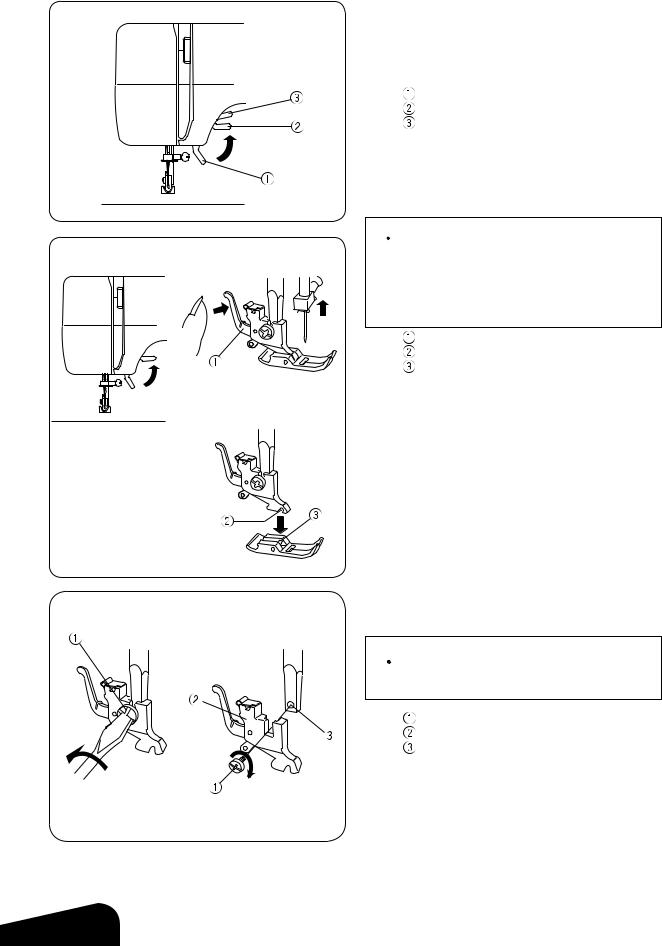
Presser foot lever
The presser foot lever raises and lowers the presser foot.
You can raise it about 1/4˝ (0.6 cm) higher than the normal up position for easy removal of the presser foot, or to help you place heavy fabric under the foot.
Lowered position Normal up position Highest position
Changing the Presser Foot
 CAUTION:
CAUTION:
Turn OFF the power switch before changing the foot. Always use the foot that corresponds to the selected stitch. The wrong foot can cause the needle to break.
Presser foot release lever
Groove
Pin
•To remove:
Turn the handwheel toward you to raise the needle bar to its highest position.
Raise the presser foot.
Push the presser foot release lever to snap off the presser foot holder.
•To attach:
Place the presser foot so that the pin on the foot lines up directly below the groove of the presser foot holder. Lower the presser foot.
Attaching and removing the presser foot holder
 CAUTION:
CAUTION:
Turn OFF the power switch before changing the presser foot holder.
Setscrew
Presser foot holder
Threaded hole
•To remove:
Remove the setscrew by turning it counterclockwise with a screwdriver.
•To attach:
Match the hole in the presser foot holder with the threaded hole in the presser bar. Fit the setscrew into the hole. Tighten the screw by turning it clockwise with screwdriver.
10
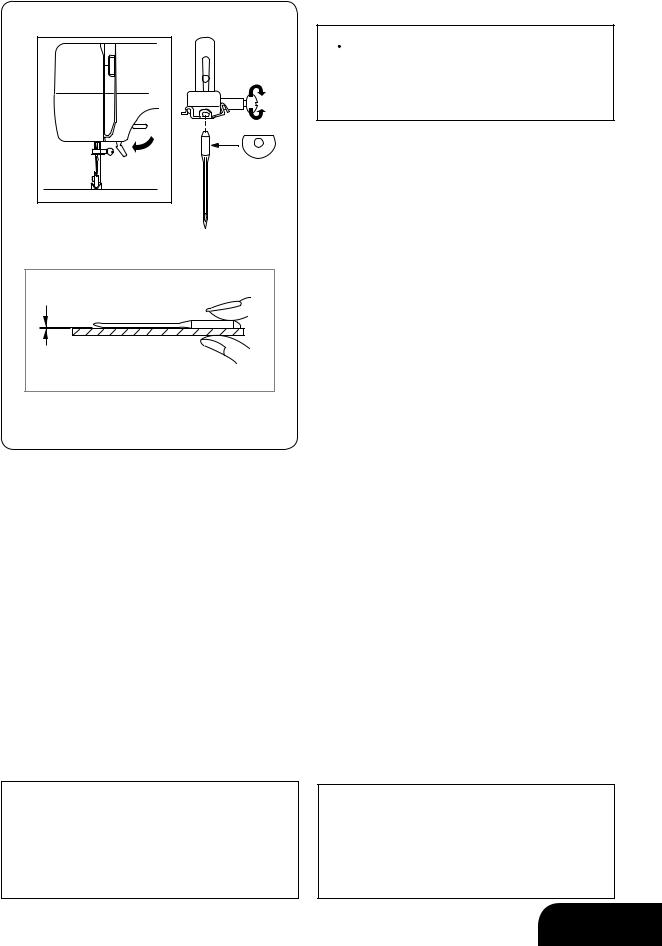
Fabric |
Thread |
Needle |
||
|
Lawn |
|
|
|
|
Georgette |
Silk #80-100 |
|
|
Fine |
Tricot |
Cotton #80-100 |
#9/65-11/75 |
|
|
Organza |
Synthetic #80-100 |
|
|
|
Crepe |
|
|
|
|
Sheeting |
Silk #50 |
|
|
Medium |
Jersey |
#11/75- |
||
Cotton #50-80 |
||||
weight |
Broadcloth |
14/90 |
||
Synthetic #50-80 |
||||
|
Fleece |
|
||
|
|
|
||
|
Denim |
Silk #30-50 |
|
|
Heavy |
Tweed |
#14/90- |
||
Cotton #40-50 |
||||
weight |
Coating |
16/100 |
||
Synthetic #40-50 |
||||
|
Quilting |
|
||
|
|
|
||
|
|
|
|
|
PLEASE NOTE:
The needle assortment includes 1 x blue shank needle (no. 11/75), 2 x no. 11/75 needles and 2 x no. 14/90 needles.
For optimal sewing results, it is recommend using Organ needles.
Changing the needle
 CAUTION:
CAUTION:
Always make sure to turn the power switch off and disconnect the machine from power supply before changing the needle.
Raise the needle by turning the handwheel toward you and lower the presser foot.
Switch off the power switch.
 Loosen the needle clamp screw by turning it counterclockwise.
Loosen the needle clamp screw by turning it counterclockwise.
Remove the needle from the clamp.
 Insert a new needle into the needle clamp with the flat side of the needle to the rear.
Insert a new needle into the needle clamp with the flat side of the needle to the rear.
When inserting the needle into the needle clamp, push it up against the stopper pin and tighten the needle clamp screw firmly.
•To check the needle:
To check needle straightness, place the flat side of the needle onto something flat (a stitch plate, glass etc.) The gap between the needle and the flat surface should be consistent.
Never use a blunt needle.
Fabric and Needle Chart
•• Use a needle size of 11/75 or 14/90 for general sewing work.
•• A fine thread and a fine needle must be used to sew lightweight fabric to prevent damage to the fabric.
•• Heavy fabric requires a needle large enough to pierce the fabric without the needle thread fraying.
•• Always test the needle size on a spare section of the fabric you will be using for sewing.
•• In general, use the same thread for the needle and the bobbin.
PLEASE NOTE:
Use a blue shank needle (available separately) when sewing flexible fabrics, very fine fabrics and synthetic fabrics. The blue shank needle effectively prevents skipped stitches.
11
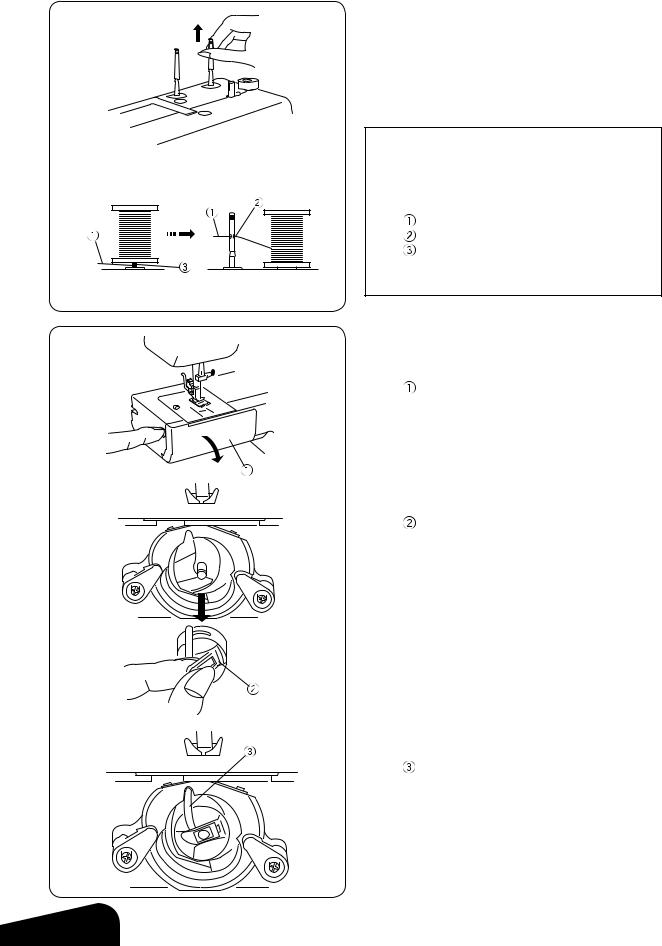
Setting Spool Pins
The spool pins are used for holding the spool of thread in order to feed thread to the machine.
To use, pull up the spool pin. Push down for storage.
PLEASE NOTE:
When using thread which has tendency to tangle around spool pin, thread through the hole of spool pin as shown. The hole should face the thread spool.
Upper thread
Hole Tangle
Removing or Inserting the Bobbin Case
Remove the sewing table by pulling it to the left. Open the bobbin cover.
Bobbin cover
Raise the needle by turning the handwheel toward you. Take out the bobbin case by holding the latch.
Latch
When inserting the bobbin case, place the horn into the recess of the hook race.
Horn
12
